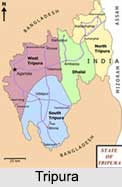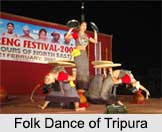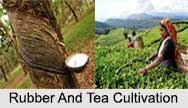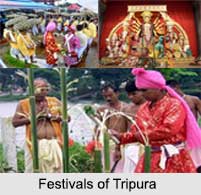 Tripura is one of the North eastern states of India that shares her domestic borders with Mizoram and Assam. Tripura, the emerald quaint hilly land laced with ancient folklores and myths have also curved out a niche for its delicate handicraft items. Tripura covers an area of 10,486 square kilometres and its capital is Agartala.
Tripura is one of the North eastern states of India that shares her domestic borders with Mizoram and Assam. Tripura, the emerald quaint hilly land laced with ancient folklores and myths have also curved out a niche for its delicate handicraft items. Tripura covers an area of 10,486 square kilometres and its capital is Agartala.
Etymology of Tripura
There are many theories regarding the origin of name of Tripura. The Sanskrit name Tripura is linked to Tripura Sundari which is the presiding Goddess of the Tripura Sundari Temple at Udaipur, one of the 51 Shakti Peethas along with the celebrated dictator Tripur, who reigned in the region.
According to another school of thought, the name Tripura was attributed to the State in honour of the Temple at Udaipur, where the major deity is Tripureshwari, Lord Shiva`s wife. According to one of the major historians, Kailash Singha, the word Tripura is derived from two words "twi" and "pra". "Twi" means water and "Pra" means near. Therefore the word means ` near water`.
History of Tripura
Tripura is mentioned in the Mahabharata and the Indian Puranas. The name is even found on the pillar inscriptions of Emperor Ashoka. Tripura was a princely state before its merger with the Indian Union. The Tripuri Kings ruled over for 3000 years. The capital of Tripura was Udaipur. Later it was shifted to Old Agartala by King Krishna Manikya in the 18th Century, and then to the present Agartala in the 19th Century. The 19th century marked the beginning of Tripura`s modern era, when King Bir Chandra Manikya Bahadur Debbarma modelled his administration on the pattern of British India and put forward various reforms. The Ganamukti Parishad movement led to the integration of the kingdom with India. Tripura was affected by the partition of India and the majority of the population now comprises of the Hindu Bengalis, many of whom came as refugees from East Pakistan after independence in 1947. Tripura became a centrally administered Union Territory on July 1, 1963 and attained the status of a full-fledged state on January 21, 1972.
 Geography of Tripura
Geography of Tripura
Tripura has an area of 10,492 square kilometres. It is the third smallest state of the country. Its altitudes vary from 50 to 3080 feet above sea level. The climate of Tripura is tropical climate and the place receives abundant rainfall during the monsoons. The state possesses an extremely rich bio-diversity.
Demography of Tripura
Tripura is the most populated state after Assam. Tripura has a population of about 3,671,032 and the literacy rate is 87.75%, which is higher than the national rate of 65.2. The tribal population comprises of different tribes and ethnic groups with a variety of language and culture. The people of Tripura are mostly tribal. The tribes of Tripura are of Tibeto-Burmese origin. The Tripuris are the largest tribe living in the west while large numbers of Reangs and Jamatias live in the north and south respectively. One will find many ethnic and scheduled tribes communities in Tripura on behalf of a pleasant social environment. These people speak Bengali language, Tripuri language and Manipuri language. Tripura is home to a major number linguistics groups and thus, it has a very complex culture.
Economy of Tripura
Agriculture is the main occupation of the people of Tripura and provides employment to about 64% of the population. There is a predominance of food crops over cash crops. About 62% Tripura is under food crop cultivation. The principal crop is Paddy. Other crops include oilseeds, pulses, potato and sugarcane. Sal, Garjan, Teak and Gamar are found abundantly in the forests of Tripura.
The important crops of the State are Tea and rubber. Tripura has been declared the Second Rubber Capital of India after Kerala by the Indian Rubber Board. Hand-woven cotton fabric, wood carvings and bamboo products also form part of the economy. Tripura has poor mineral resources, with meagre deposits of kaolin, iron ore, limestone, coal and natural gas. The industrial sector of the state is underdeveloped.
 Government of Tripura
Government of Tripura
Tripura is governed through a parliamentary system of representative democracy. Tripura sends two representatives to the Lok Sabha and one representative to the Rajya Sabha. Panchayats are being elected by local body, elections are present in many villages for self-governance. Tripura also has a unique tribal self-governance body, the Tripura Tribal Areas Autonomous District Council. The main political parties are the Bharatiya Janata Party (BJP), the Left Front and the All India Trinamool Congress along with regional parties like IPFT, INPT and the Indian National Congress.
Education in Tripura
Tripura schools are run by the state government or by the private organisations which also include the religious institutions. The medium of instruction is mainly in English or Bengali. Kokborok and other tribal languages are also used. The Secondary schools are affiliated to CISCE, CBSE and the Tripura Board of Secondary Education. After completing the Secondary school, students enrol in junior colleges for two years. The important higher education institutions of Tripura are MBB College, National Institute of Technology and Tripura University.
 Culture of Tripura
Culture of Tripura
Tripura comprises of a variety of ethno-linguistic groups, which have resulted in a composite culture. The dominant culture is Bengali. The minority cultures are those of the Tripuris, Jamatia, Reang, Noatia, Koloi, Murasing, Chakma, Halam, Garo, Kuki, Lushai, Mogh, Munda, Oraon, Santhal and Uchoi. Hinduism is the major religion in the state.
The people of Tripura are music lovers. Some of their important musical instruments are sarinda (an instrument similar to the lutes or fiddle), chongpreng and sumui (a kind of flute). Songs are sung on important and sacred occasions like marriages and other festivals. They are also interested in fine arts, handicrafts and dance. Dances are performed during Goria puja. The two types of dances of the people are the Hojagiri dance and the Bihu dance. Hojagiri dance is performed by Reang clans by standing on a pitcher. The Bihu dance is performed by the Chakmas during Chaitra Sankranti.
Tripura is noted for bamboo and cane handicrafts. Bamboo, wood and cane are used to create an array of furniture, utensils, hand-held fans, replicas, mats, baskets, idols and interior decoration materials.
Festivals of Tripura
Durga Puja, Kali Puja, Dolyatra, Ashokastami, Navaratri, Vijayadashami and the worship of the Chaturdasha deities are important festivals in the state. Some festivals represent confluence of different regional traditions, such as Ganga puja, Garia puja, Kharchi puja and Ker puja. Unakoti, Pilak and Devtamura are historic sites where large collections of stone carvings and rock sculptures are noted.
Tourism of Tripura
Tripura owes its splendour to its natural settings and dazzling heritage. The landscape of Tripura is neither punctuated by lofty peaks nor any cascading rivers. Yet for ages tourists have swarmed the region because its verdant expanses and rich forestlands have enamoured the visitors. A glut of delightful attractions are comprised in the historical palaces, rock cut carvings, stone sculptures, Hindu and Buddhist temples, wildlife sanctuaries and tribal people. Some of the tourist attraction sites are Kamalasagar, Ujjayanta Palace, Udaipur, Neermahal, Matabari Temple and many other pilgrimage sites and nature tourism places in Tripura.
Visiting Information of Tripura
Agartala Airport is located at 12 kilometres northwest of Agartala at Singerbhil. The major railway stations in this line are in Agartala, Dharmanagar, and Kumarghat. Only one major road, the National Highway 8 (NH-8), connects Tripura to the rest of India.






